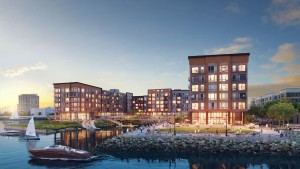
Demand for new luxury condos has spread to former working-class enclaves such as East Boston, where developer Lendlease recently began presales of the 80-unit Slip65 scheduled to open in fall 2018.
The Boston condominium market is experiencing a trajectory never before seen in the history of the city. Spectacular towers attaining prices in excess of $2,500 per foot have established Boston as a competitive player on a worldwide stage. Millennium Tower, 22 Liberty, The Pierce, One Dalton and Pier 4 have each established the high-water mark in their respective neighborhoods.
As the positive condominium market cycle has continued to surpass the duration of any of its predecessors, there are trends emerging that transcend neighborhoods on price points.
Consumers at all levels are valuing walkability, convenience, new construction and efficient design.
Urban core pricing is also producing a flight to affordability, so although the development “rings” of the city are expanding to tertiary markets, the consumers’ expectations have not diminished.
There are buyers at every level. The influx of well-compensated Millennials, move-up couples who prefer an urban lifestyle and empty-nesters flush with equity are still plentiful. Pair that buying power with a plethora of foreign investors anxious to “park” cash in a stable economic environment and our “buyer cup runneth over!”
Although each of these buyer segments have their financial thresholds, their purchase motivators remain the same.
Today’s consumers want to be able to save time, live near work and enjoy experiences and top conveniences. “The Neighborhood” has become less important – it has given way to the next wave of gentrification and opportunity – think Ink Block, Fenway, Seaport … all creating a new sense of place. Never before has the Boston consumer been so neighborhood-agnostic – it doesn’t matter where – but what? Where do I shop, eat, buy groceries, workout, socialize, play? The answers to these questions are decision makers for today’s consumers.
As with any stratification, “How much?” matters too. Hence, the birth of the “outliers” – Somerville, South Boston, Allston and East Boston, all formerly home to blue-collar workers and triple-deckers. The flight to affordability has elevated these next-tier markets to opportunities for development, most located on public transit. This next level of “mid-luxury” development has provided an alternative to those priced out of the urban core.
Amenities abound, clearly separating the new construction from the last generation. However, this time it’s less about the physical and more about the psychological. Concierge, experiences, events, personal assistants, party planners, dog walkers – all to make life easier, more conceivable and more immediate. Free time is precious to these consumers and they value these “amenities” at every level.
Smart design has no price tag. As prices per foot escalate, efficiency and creativity become all more valued. A 750-square-foot one-bedroom lives the same as a 685-square-foot unit, if designed correctly. Absolute dollars matter. Consumers don’t pay price per foot; today’s developers understand that consumers look for a livable program, not square footage.
This development cycle has produced an evolution of “neighborhoods.” It’s not just Back Bay or Beacon Hill. It’s Seaport, Fenway, South End, Eastie, South Boston, Allston and Somerville: each offering a unique, elevated lifestyle, a connected fabric that provides convenience and a sense of place that transcends a geographical location. Each new neighborhood is heralded by a signature building, whether it’s Millennium Tower in Midtown, 22 Liberty in the Seaport, The Pierce in Fenway or Siena/Sepia at Ink Block.
These developments were pioneers in their neighborhoods, precursors to the evolution of their broader communities and creating a new place. Each will be the legacy of this cycle – creating “places” will be the result.
Sue Hawkes is managing director of The Collaborative Cos. of Boston.




 |
| 



